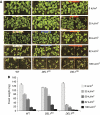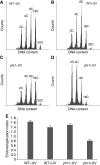Atypical E2F activity coordinates PHR1 photolyase gene transcription with endoreduplication onset
- PMID: 21131907
- PMCID: PMC3025459
- DOI: 10.1038/emboj.2010.313
Atypical E2F activity coordinates PHR1 photolyase gene transcription with endoreduplication onset
Abstract
Because of their sessile life style, plants have evolved the ability to adjust to environmentally harsh conditions. An important aspect of stress adaptation involves the reprogramming of the cell cycle to ensure optimal growth. The atypical E2F transcription factor DP-E2F-like 1 (E2Fe/DEL1) had been found previously to be an important regulator of the endocycle onset. Here, a novel role for E2Fe/DEL1 was identified as a transcriptional repressor of the type-II cyclobutane pyrimidine dimer-photolyase DNA repair gene PHR1. Upon ultraviolet-B (UV-B) treatment, plants knocked out for E2Fe/DEL1 had improved DNA repair abilities when compared with control plants, whereas those overexpressing it performed less well. Better DNA repair allowed E2Fe/DEL1 knockout plants to resume endoreduplication faster than control plants, contributing in this manner to UV-B radiation resistance by compensating the stress-induced reduction in cell number by ploidy-dependent cell growth. As E2Fe/DEL1 levels decreased upon UV-B treatment, we hypothesize that the coordinated transcriptional induction of PHR1 with the endoreduplication onset contributes to the adaptation of plants exposed to UV-B stress.
Conflict of interest statement
The authors declare that they have no conflict of interest.
Figures







References
-
- Barow M, Meister A (2003) Endopolyploidy in seed plants is differently correlated to systematics, organ, life strategy and genome size. Plant Cell Environ 26: 571–584
-
- Bowler C, Benvenuto G, Laflamme P, Molino D, Probst AV, Tariq M, Paszkowski J (2004) Chromatin techniques for plant cells. Plant J 39: 776–789 - PubMed
-
- Boyko A, Greer M, Kovalchuk I (2006) Acute exposure to UVB has a more profound effect on plant genome stability than chronic exposure. Mutat Res 602: 100–109 - PubMed
Publication types
MeSH terms
Substances
LinkOut - more resources
Full Text Sources
Other Literature Sources
Research Materials

